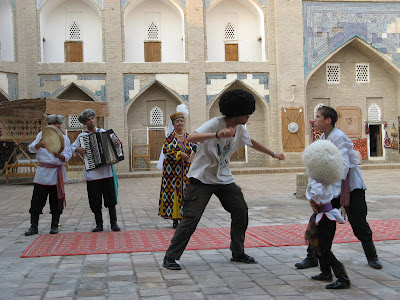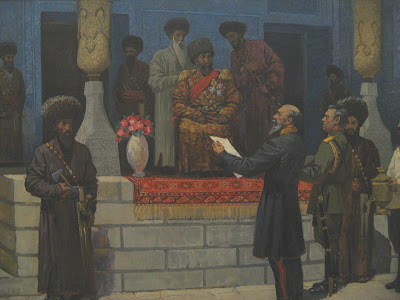
We woke up in our reasonable hotel in the town of Nukus in Karakalpakstan; an autonymous republic of Uzbekistan. The Karakalpak are ethnically diferent to Uzbeks. They have more mongolian features.
We decided to head for Khiva south of the Amu Darya River in Khwarezm (named after the Khwarezmshahs who were the Seljuk Turks that conquered the region in the 11th century).
We found a friendly taxi driver to take us to the bus station where it took us most of the morning to figure out that there were no buses to Khiva because the bridge over the Amu Darya River had been washed away. So we had to get a taxi that would take most of the rest of the day to go the long way round. And would cost considerably more.
As soon as we left Nukus we were in desert.
After an hour or two the desert abruptly gave way to green fields and within minutes we reached the Amu Darya River. It is a wide river in this area and from here it splits into many branches to form a delta. The delta used to flow into the Aral Sea. But the Aral Sea disappeared after river water was diverted by the Soviets to irrigate the land and grow cotton for export. The Aral Sea used to support a good fishing economy and wetlands there supported wildlife. Now the region is a manmade dustbowl. With all the land being used to grow cotton for foreign export there have been food shortages and famines. To make matters worse, the huge amounts of chemical fertilisers that were put on the land ended up in all the mud of the river beds and the Aral Sea which dried up and became poisonous air-borne dust.
We qued up to cross the Amu Darya on a floating bridge type thing.

This is the courtyard in front of the Alloquli Khan Medrassa (right) and the Muhammad Amin Inog Medressa (left). The oriental medieval city is like something from a fairy tale. It is a real-life backdrop to exotic legends of romance, merchants, magic, princesses and skulduggery.
Eventually we reached Khiva. These are the old city walls. Its a small town and most of it is still within the old city walls, which seem to be in good condition.
We went into the city and found a friendly little family-run guest house. There were only two rooms for guests and a shared bathroom. Breakfast was served in the main room which was the family's living room. Our host was a young girl who was only about 16. The rest of the family didn't speak English. After we left our bags there we went for a wander about the place.

This is the courtyard in front of the Alloquli Khan Medrassa (right) and the Muhammad Amin Inog Medressa (left). The oriental medieval city is like something from a fairy tale. It is a real-life backdrop to exotic legends of romance, merchants, magic, princesses and skulduggery.
This is a minaret that was never completed. It is called the Kalta Minor Minaret and was began in 1851. It was going to be so high enough to see all the way to Bukhara (a long way away). When the Khan died it was never finished.
The Alloquli Khan Medressa. A Medressa is an Islamic school. A bit like a monastery or a convent. They were really important centres of learning and knowledge in the East long before there were universities in the West. Islamic scholars in the 8th-14th centuries developed the fundamentals of modern arithmetic, geometry, astronomy and science.
Women making bread in a clay oven called a tandor. Similar word to Tandoor as in Tandoori - an Indian clay oven.
Typical view of one of the many courtyards in Khiva. It wasn't very busy. In the background is the Islom-Hoja Minaret. It looks a bit like a lighthouse.
We caught a performance of traditional dancing and I got roped-in. Yes that's me with the hat on. They pull alot of extreme facial expressions when they dance and they are very energetic. They also wear these big hot and sweaty and very smelly hats. The dancer put it on my head - great, thanks for that! - it stank like vinegar and was all wet and nasty!
We climbed up the minaret of the Juama Mosque and got a view down on the city. These are some of the rooftops.
You can see the edge of the town. Its not a very big place. And beyond you can see the lush green irrigated fields - probably growing cotton. And beyond that you can see the desert. Thats the house where we stayed right there in the middle of the picture. This photo is looking toward the south-east.
Looking down at the Muhammed Amin Inog Medressa and the Alloquli Khan Medressa. This photo is looking to the west.
Photo looking north-west toward the Khuna Ark. That tall tower in the distance is the old Khan's pavillion.
Entrance to the Khuna Ark. Thats where the Khan's residence and all the important stuff was like government ministers and the treasury.
Painting of the last Khan of Khiva meeting the Russians in the 1920s when Khiva became part of the USSR. Khiva was the last Khanate to join the Soviet Union.

















































No comments:
Post a Comment